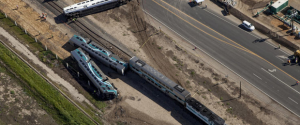The Steel Wheels Column
An occasional commentary by Paul Dyson, RailPAC President

As I write (March 3rd) I have just heard that Glenn Steele, the Amtrak employed engineer of the Metrolink train that hit a truck on the tracks at Oxnard February 24 has died of his injuries. The 62 year old was the senior engineer at Metrolink and had a 40 year railroad career. While I hesitate to jump to conclusions ahead of the STSB report I feel strongly that this death should not have occurred for a number of reasons. So here are my questions to SCRRA (Metrolink), VCTC, CPUC, and the rest of the alphabet soup of agencies that are supposed to address these issues:
Metrolink Board members and spokespersons immediately claimed that the Crash Energy Management system on the Rotem cars had saved lives. Really? It did not do much to protect the engineer as promised. From the photographs of the wreck there does not appear to be any deformation of the ends of the cars. Did the crumple zones miraculously “uncrumple” after the collision? CEM certainly did not prevent the passengers being tossed around inside the train like rag dolls.
Modern coupling systems used on passenger trains around the world are designed to keep derailed trains “in line and upright”. What went wrong here? Has Metrolink spent millions on new trains with couplers that were not fit for purpose? Did the politically appointed SCRRA Board really understand what they were purchasing?

Again, looking at pictures of the crossing, I don’t see much in the way of markers to warn drivers not to stray off the crossing onto the track. Should not the CPUC mandate high visibility stripes or reflective studs to delineate the roadway? That would surely make it harder for a driver to make a premature right turn onto the tracks, especially at night. How expensive would that be for poor Ventura County and the City of Oxnard, who claim they cannot afford to grade separate the crossing. After a dozen incidents here, at what point do public agencies take action?
I’ll be taking a more serious stance on safety in the coming months. As I wrote last month, Railways are dangerous places. Rail passenger travel is made safe by technology, systems, operating discipline and the strict adherence to rules and procedures.
Paul Dyson
President
[email protected]
